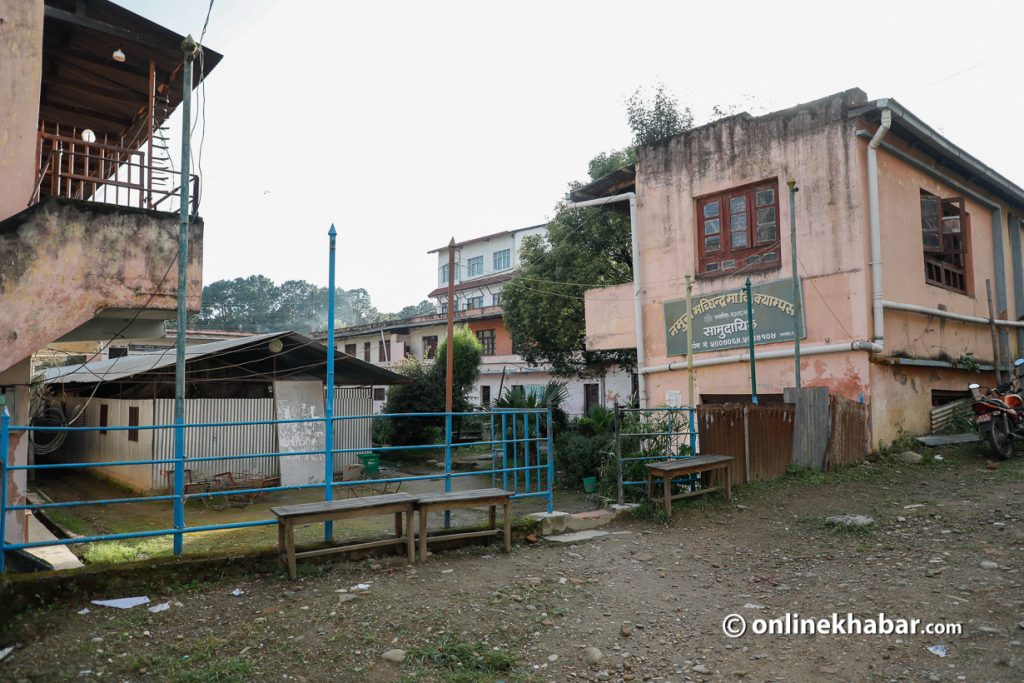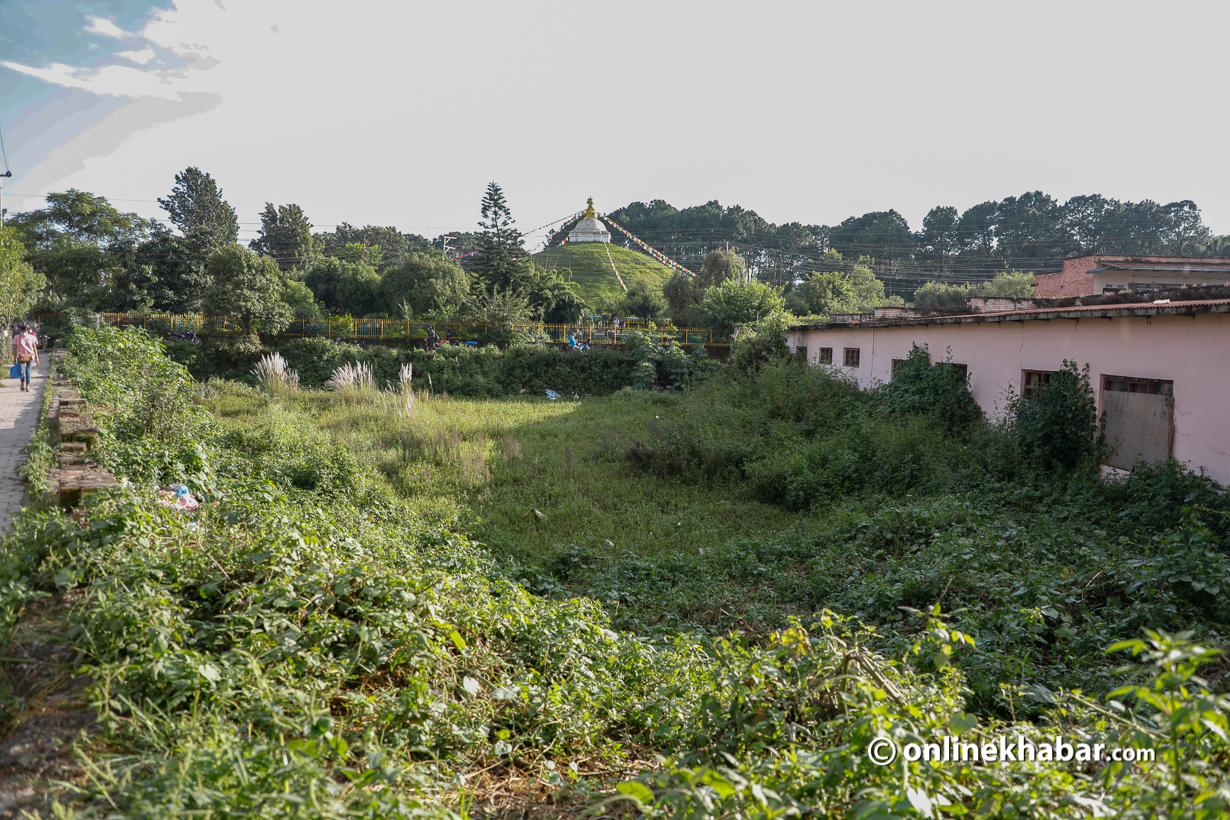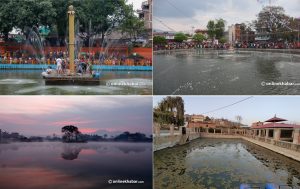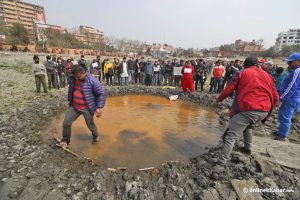At a busy junction in Lagankhel, Lalitpur, further from the bus station, lies a land plot that once had a huge pond called Saptapatal Pokhari. The pond, which had a lot of religious significance, gradually got lost during the Kathmandu valley’s urbanisation drive. The state canals (rajkulos) that recharged the pond were quashed during the expansions of roads, and the pond lay lifeless for over three decades.
But, things are changing now. Locals of the area along with the Lalitpur metropolitan city have prepared a detailed project report (DPR) as efforts have been made to restore the pond. A budget of Rs 40 million has been set aside as the city government is soon to call a tender for the task. However, to get to this point, they have had to deal with a lot. From having to reclaim land from a school to facing a lawsuit, it took locals 15 years to ensure that the pond, Saptapatal Pokhari, would be restored to its former glory.
Hiding heritage
Close to the pond is Namuna Machhindra School, a public school established in 1965. By 1978, as the Land Revenue Act was drafted, some part of the land belonging to the Saptapatal Pokhari came under the school’s name. Locals found out the error and started opposing this. By 2004, they went to the Supreme Court asking the judiciary to remove the pond from the plot under the name of the school and put it under a government property instead. But, the court did neither as it stated that that land where the pond was belonged to the pond and was not public property.
But, things started to get heated after 2004. Locals started to do their own research as they found a minute that stated the school was planning to bury the pond because it feared that students would fall into it.
“That is what irked us. First, you encroach public property. Then, you try to remove an important heritage monument and a water recharger. We couldn’t stand and watch,” says Purna Sthapit, a Lagankhel local who has been fighting to get the land back from the school for the past 15 years.
It was around then that the school decided to build a new building. With the pond in a prime location, the school wanted to build a commercial building and rent it out. This, even though it was against the court orders, was allowed to happen by the Lalitpur metropolitan city.
Protests intensified. Police had to intervene when locals obstructed the construction.
“We didn’t want to do that, but when the authorities turned a blind eye, we had to step up,” says Sthapit.
Uncovering the covered

By 2005, the school along with contractors had laid the foundation for the building to be built in the Saptapatal Pokhari area. Frustrated locals called on the Department of Archaeology for help, and the department asked the school and contractors to stop the construction. Things went quiet for a while as the locals established a reconstruction committee in 2009.
The committee started cleaning the pond premise preparing to revive it, but that plan was put to hold after Namuna Machhindra School filed a writ petition, asking the court to stop the pond’s revival.
“The court ruled in favour of the school. It made no sense how and why when it earlier said that it was the pond’s land,” says Sthapit, who then filed a writ petition on his own asking the court to allow the efforts to revive the pond.
The court did rule in favour of the locals and asked the school to allow the revival efforts. But, the school did not budge. Sources close to the case say the school had a lot of influence as people like Agni Kharel and Subas Chandra Nembang fought on behalf of the school.
“It was clear this had become political,” says Sthapit.
Yet, the locals did not budge. Despite the case’s date shifting over 100 times, they continued the fight. Sthapit says over the course of the past 15 years, he has had to hire 10 lawyers and has been to the court nearly 100 times. And his dedication towards the cause finally rewarded him as the court on July 8, 2019, ruled in favour of Saptapatal Pokhari.
The final respite
With the court making its final decision, Lalitpur metropolitan city has been stepping up its effort to restore the Saptapatal Pokhari. It has already prepared its detailed project report as a tender will also be called in the forthcoming weeks. Around Rs 40 million has already been set aside by the municipality for the project.
“The work will start soon. Hopefully, we can finish it by the time the Rato Machhindranath Jatra begins next summer,” says Raju Maharjan, the spokesperson of the city.
The DPR has been prepared by water expert Padma Sunder Joshi, rainwater expert Prakash Amatya, Pushpa Man Amatya, Surendra Shrestha and Purna Bahadur Shrestha.
According to the city government, the buildings that were constructed on the pond will be demolished as it wants to make a pond in 4.3 acres of land. The funds will be used to construct a pati, a resting place, and walls around the pond.
“After fighting for 15 years, I’m very tired. I did this because of my faith and I wish to see the pond restored before I die,” says Sthapit, who is in his seventies.
Even though efforts have started, it is going to be quite a challenge to get the pond back to its former glory, says Padma Sunder Joshi. He says restoring the pond is not going to be as hard as they can use the methods used in Ranipokhari in Kathmandu and Bhajya Phuku in Bhaktapur.
“The main problem will be to recharge Saptapatal Pokhari. There was a state canal that ran from Tika Bhairav in Lele to the pond. But, due to road expansions that is now gone, we are looking at how we can recharge it,” says Joshi.


























